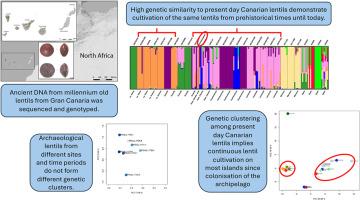来自小扁豆(Lens culinaris)的古代DNA揭示了加那利群岛人类-植物-文化的相互作用
IF 2.5
1区 地球科学
Q1 ANTHROPOLOGY
引用次数: 0
摘要
人类与作物之间的亲密关系意味着人类文化实践的痕迹嵌入了作物基因组中。因此,对考古作物遗骸的基因分析使得研究社会变化的文化后果成为可能。加那利群岛具有独特的文化历史,15世纪西班牙人的殖民统治导致土著文化被消灭,人类基因库被部分取代,岛屿迅速转变为新旧世界之间的全球化中心。虽然这些事件的许多方面都是众所周知的,但文化更替与栽培作物之间的相互关系却很少得到研究。本研究首次成功对扁豆(Lens culinaris)千年种子进行了全基因组测序和KASP基因分型。与现在的小扁豆的比较表明,直到现在,土著小扁豆一直在加那利群岛上持续种植。我们认为,这是由农业责任和继承的性别分工以及对当地气候的适应促成的。我们证实了之前提出的在欧洲人到来之前的长期岛屿间隔离,并证明了在欧洲人到来之前,扁豆被认为已经消失的岛屿上也有持续的扁豆种植。研究结果进一步暗示了加那利扁豆在欧洲大陆扁豆种植和消费中的作用。总而言之,对古代扁豆DNA的首次分析表明,未经充分研究的考古植物遗骸如何揭示没有书面记录的过去文化的各个方面。本文章由计算机程序翻译,如有差异,请以英文原文为准。

Ancient DNA from lentils (Lens culinaris) illuminates human - plant - culture interactions in the Canary Islands
The intimate relationship between humans and crop plants means that traces of human cultural practices become embedded in the crop genome. Genetic analyses of archaeological crop remains thus allow cultural consequences of societal change to be studied. The Canary Islands have a unique cultural history where the Hispanic colonization in the 15th century led to eradication of the indigenous culture, partial replacement of the human gene pool and a rapid transformation of the islands into a globalization hub between the Old and the New World. Although many aspects of these events are well known, the interconnections between the cultural turnover and cultivated crops have rarely been studied.
In this study full genome sequencing and KASP genotyping have, for the first time, been successfully carried out on millennium old seeds of lentil (Lens culinaris). Comparisons with present day lentils reveal that indigenous lentils were kept in continuous cultivation on the Canary Islands until the present. We suggest that this was facilitated by a gendered division of agricultural responsibilities and inheritance as well as adaptation to the local climate. We confirm a previously suggested long-term inter-island isolation prior to the arrival of Europeans and demonstrate continuous lentil cultivation also on islands where they were believed lost prior to the arrival of Europeans. The results furthermore hint to a role of Canarian lentils in the cultivation and consumption of lentils on the European mainland. To conclude, this first analysis of ancient lentil DNA show how understudied archaeological plant remains can reveal aspects of past cultures not documented in written records.
求助全文
通过发布文献求助,成功后即可免费获取论文全文。
去求助
来源期刊

Journal of Archaeological Science
地学-地球科学综合
CiteScore
6.10
自引率
7.10%
发文量
112
审稿时长
49 days
期刊介绍:
The Journal of Archaeological Science is aimed at archaeologists and scientists with particular interests in advancing the development and application of scientific techniques and methodologies to all areas of archaeology. This established monthly journal publishes focus articles, original research papers and major review articles, of wide archaeological significance. The journal provides an international forum for archaeologists and scientists from widely different scientific backgrounds who share a common interest in developing and applying scientific methods to inform major debates through improving the quality and reliability of scientific information derived from archaeological research.
 求助内容:
求助内容: 应助结果提醒方式:
应助结果提醒方式:


